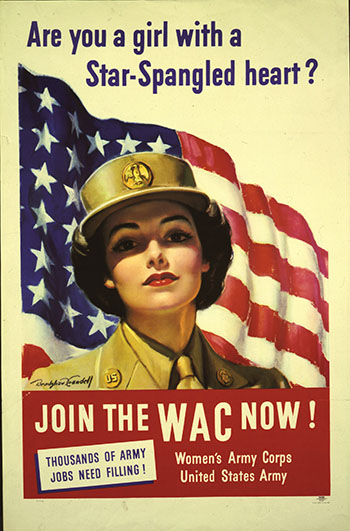|
 Beginning
in October 1940, men between 21 and 35 were drafted for mlitary service and
on December 11, 1941, the US declared war on against Japan's allies, Germany
and Italy. As their husbands, sons and brothers left home, many American
women asked, “how about us?” Acting as their spokeswoman, Representative
Edith Nourse Rogers (Massachusetts) introduced a bill in May 1941 calling
for the creation of an all-volunteer women's corps in the Army. Beginning
in October 1940, men between 21 and 35 were drafted for mlitary service and
on December 11, 1941, the US declared war on against Japan's allies, Germany
and Italy. As their husbands, sons and brothers left home, many American
women asked, “how about us?” Acting as their spokeswoman, Representative
Edith Nourse Rogers (Massachusetts) introduced a bill in May 1941 calling
for the creation of an all-volunteer women's corps in the Army.
Initially, members of
Congress, the press and the military establishment joked about the notion of
women serving in the Army, but as America increasingly realized the demands
of a war on two fronts (Japan and Germany), leaders also faced an acute
manpower shortage. In May 1942, the House and the Senate approved a bill
creating the Women's Army Auxiliary Corps (WAAC) and
Oveta Culp Hobby,
Chief of the Women's Interest Section in the Public Relations Bureau in the
War Department and a lobbyist for the WAAC bill, became its first director.
Although the women who joined considered themselves in the Army,
technically they were civilians working with the Army. By spring of
1943, 60,000 women had volunteered and in July 1943, a new congressional
bill transformed the WAAC to the Women's Army Auxiliary (WAC), giving Army
women military status.
The Army opened five WAAC training centers and
in July 1942, the first group of 440 women officer candidates (40 of whom
were African American) and 330 enlisted women began training at Fort Des
Moines, Iowa. Uniform supply was inadequate but it did not deter training.
Except for weapons and tactical training, the women's courses paralleled
those for Army men, as did their training circumstances. One WAC later
remembered her basic training: "We
went through Officer Candidate School in tennis shoes, foundation garments,
seersucker dresses with bloomers and gas masks. Apparently there was a
supply mix-up somewhere in the pipe line. The overconcern with underwear by
the male planners paid dividends. But they were not pink with lace. They
were tannish and awful. Foundation garments, such as even our grandmothers
would not have worn, did give us moments of hilarious parading in our
barracks after the “study hour.”
In 1942, WAACs began deploying overseas. As the war continued, most
overseas assignments were to the European Theater of Operations an over
8,300 served in England, France, Germany and Italy. Others deployed to the
Pacific and the Far East. Five WAAC officers had a harrowing experience en
route to reporting for duty at Allied Headquarters in Algiers, North Africa.
The troop ship on which they traveled from England to North Africa was
torpedoed by a German U-boat in the North Atlantic. A British destroyer came
to the rescue and saved the women officers ando other survivors of the
burning, skining ship and delivered them safely to Oran, Algeria. They lost
uniforms, cosmetics and personal items and were smeared with oil and grit,
but the welcoming party at the port brought oranges, toothbrushes and
emergency items. Within a few days they were at work in Allied Headquarters.
Women performed their duties like seasoned troopers—even amid unhealthy and
uncomfortable conditions. One women stationed in the Philippines explained:
"We were warned to keep our sleeves
down, wear our wool socks. . .watch out for wallabies (small rodent-like
kangaroos that bumped under our cots at hight), tarantulas (dump boots every
morning), and snakes. . .The tents were hot during the day and cold at night
because we were sitting right on the Equator."
General Douglas MacArthur, the
Supreme Allied Commander, was among high-ranking officers praising the
women, calling them “my best soldiers,” and alleged that they worked
harder than men, complained less and were better disciplined. . .he would
take any number of the WACs the War Department would give him in any future
command he might ever have.
........................................................................................................................................................................................................................................................................................
The information in this
article is excerpted from “Women's Army Corps: WAAC and WAC” by Colonel
Betty Morden, USA (Ret.). Colonel Morden's essay appears in
In Defense of a
Nation: Servicewomen in World War II, edited by Major General Jeanne M.
Holm, USAF (Ret.) and Judith Bellafaire, Ph.D., Chief Historian of the
Women's Memorial Foundation (Arlington, Virginia: Vandamere Press, 1998).
|
